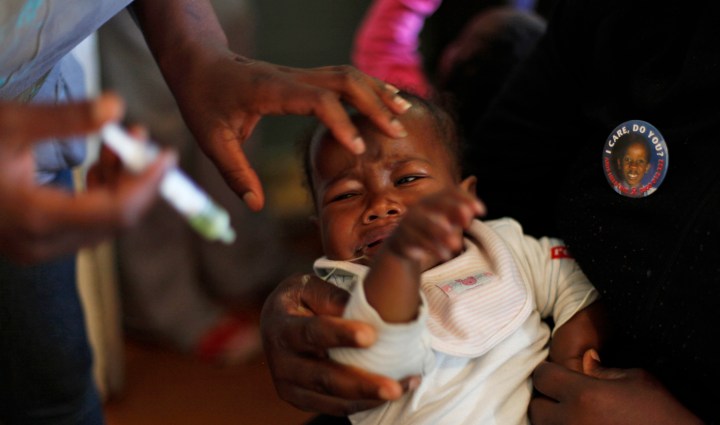South Africa
2011 antenatal HIV survey: What’s with the sporadic increases?

As in the 2010 survey, too, the latest antenatal HIV survey indicates there is an uptick in the number of HIV-positive antenatal patients in certain areas of the country, whilst the general trend is in a plateau. The department of health is still not sure why this is happening, though what is clear is that the problem is still massive. By SIPHO HLONGWANE.
According to the department of health’s National Antenatal Sentinel HIV & Syphilis Prevalence Survey in South Africa for 2011, several provinces showed increases in the number of HIV-positive antenatal patients. These included the Free State, North West, Limpopo and Mpumalanga.
KwaZulu Natal still has the highest prevalence, followed by Mpumalanga, the Free State and North West, all with a prevalence rate of 30% or higher. The Northern Cape and Western Cape were the only two provinces with less than 20%. Women between the ages of 15 and 24 recorded a 21.8% rate (this figure is used to estimate the rate of new infections, as these women are assumed to be have been relatively recently infected) – while the national average was 29.5%. The department estimates that 5.6 million people in South Africa are living with the disease today.
Some 33,446 first-time antenatal patients participated in the survey.
The rate of infection fluctuates greatly across the country, and there are signs that this has something to do with the availability of contraceptive devices. The department’s representative for HIV, tuberculosis and child and maternal health, Yogan Pillay, said that condom distribution in some regions provided a clue: in Gert Sibande in Mpumalanga, for example, condom distribution stood at 18 condoms per male per year, while HIV prevalence stood at 46.1%. In Eden, in the Western Cape, condom distribution was 40 per male per year, and HIV prevalence stood at 16%. Now, the department is planning to increase the supply of condoms in areas where more than 40% of women are testing positive.
In order to better understand why some regions are worse hit than others, and also why these areas suddenly experienced jumps in infection rates, better surveys and studies are needed, health minister Aaron Motsoaledi said.
“To start with, there is need for analytical epidemiological surveys based on scientific study in the highly-affected areas to understand the factors driving the epidemic,” he said.
Like he did last year, he ominously suggested that areas that saw an influx of migrant workers due to new construction work, like the new power stations in Mpumalanga and Limpopo, saw an increase in infection rates.
But there is some good news. Not only is the national rate hovering around the 29% mark, like it has since 2005, but there were 26 regions with above-average numbers in 2011, compared with last year’s 28.
Because of the stigma still attached to HIV/Aids in South Africa, it is difficult to get people to volunteer for these surveys. Many people simply don’t get tested at all. This is why the department of health uses antenatal patients as a sample for the rest of the population. Not only have they definitely had sex in the previous months, but the benefits are numerous. Modern science can now prevent the mother from transmitting the disease to her newly-born child. This makes them more receptive to testing.
Research by the department shows that maternal deaths are on the decrease for the first time, thanks to Aids drugs.
The National Committee for the Confidential Enquiries into Maternal Deaths found that the institutional maternal mortality ratio fell almost 16% year on year to 156.5 per 100,000 live births last year. This was down from 186 per 100,000 in 2010 and 189 per 100,000 in 2009, BusinessDay reported.
The excellent news is that the department is very keen to get a grip on the pandemic, even if it has been struggling to push it back for seven years now. As soon as someone comes up with a new way to either treat or stop infections, Motsoaledi and his crew leap onto it. Unfortunately we need to wait for a few years before we see their solutions beginning to take effect.
Motsoaledi has always warned that we will in all likelihood see more people living with HIV/Aids in coming years, which will simply be a sign that antiretroviral treatment is working. When that starts happening more, the focus may shift towards testing younger people to get a clearer data on how the virus is spreading.
In coming surveys, syphilis will be dropped. The numbers are so low as to be insignificant, at least compared to HIV. Motsoaledi said that they would be testing for herpes simplex instead.
But for now, the message is clear. We need to roll out treatment and education programmes more swiftly. There is something chilling about the fact that HIV/Aids is still being spread into rural areas thanks to new infrastructure. That’s not how development is supposed to work. DM
Read more:
- The 2010 antenatal HIV survey: hold on, don’t cheer yet in Daily Maverick
Photo: An infant receives medication at Nkosi’s Haven, south of Johannesburg November 25, 2011. REUTERS/Siphiwe Sibeko
















